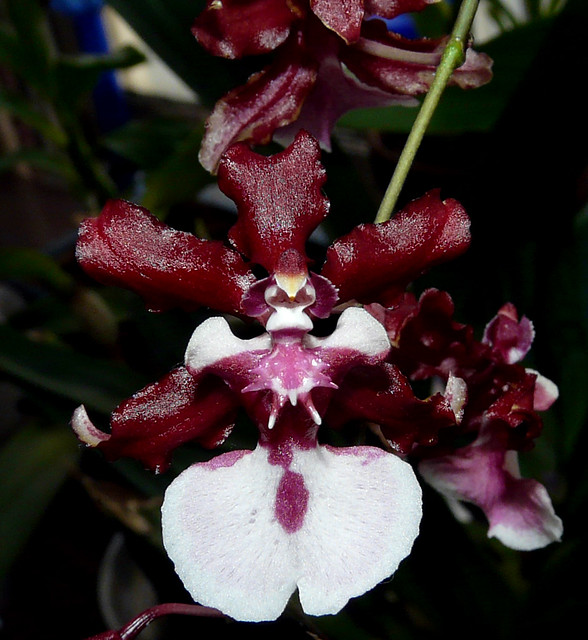Oncidium Orchids, also known as “Sharry Baby Orchids” and “Chocolate Orchids” are perfect for every garden. No matter if you’re a beginner or an expert, they’ll bring something unique to your arrangement.
Chocolate Orchids produce stunning blossoms and a sweet scent. These are the two driving factors behind their popularity. Plus, it’s really easy to care for them.
Here’s how to grow a Chocolate Orchid.
Table of Contents

1. Potting

Chocolate Orchids rely on open, free-draining media to grow at their maximum potential. As such, there are plenty of ways you can pot them.
Keen gardeners that like to ensure their plants have lots of water should pot Chocolate Orchids in medium-grade soil based with bark. On the other hand, those that tend to under-water plants should use fine-grade soil based with bark, sphagnum moss, or a mixture of both.
Note that potting soil and peat moss should be avoided. This is because this type of soil retains too much water that a Chocolate Orchid actually needs to grow.
2. Choosing A Pot

In terms of the right pots to use, again there are plenty of options available so you can experiment to find the best that suits your needs.
Terracotta pots are often used to grow orchids as water can evaporate quickly. This is the best option for beginners as they are readily available from most garden stores.
On the other hand, you could use a clear plastic pot for growing Chocolate Orchids. These work well as they make it easy to check on the plant and they expose the roots to sunlight which will prevent them from rotting.
Gardeners that tend to over-water their plants should consider using basket-style pots as their open sides mean that the potential for drainage and airflow is high, keeping the plant healthy and maintained.
3. Humidity
Chocolate Orchids require quite high humidity to grow. You can easily create this in your garden by placing the pot on top of a bed of decorative pebbles.
Once the plant has been watered, any excess drains through the holes at the bottom of the pot and will collect in the pebbles underneath. The humidity around the plant will then increase to a good level as the trapped water starts to evaporate.
4. Watering
Like with all plants, it’s important to keep your Chocolate Orchid watered and healthy. How much and how often you should water your plant depends on its size, where you plan on keeping it, the type of pot you are planting it in, the potting media, how much light it is exposed to and how much airflow it gets.
Generally speaking, Chocolate Orchids like to be watered a lot. That said, while it’s still growing, you should only water the plant when the media is almost dry. Once it’s grown out to its final form, you should only water it when the media has fully dried out. Of course, the time between each water depends on the factors noted above.
It’s simple to check if your plant is being watered enough by keeping an eye on its pseudobulbs. If they are shriveled up, your Chocolate Orchid is not getting enough water.
5. Light
This is the trickiest part of growing a Chocolate Orchid, but it’s still simple to overcome.
There is some debate as to how much light you should give your plant; some people think that low to medium light is best, while others believe that they need full access to the sun to grow best.
Two things that everyone agrees on: too much sun will produce brown spots on its leaves, causing them to dry out, while too little sun will prevent the plant from growing at all.
6. Placement
Plant your Chocolate Orchid where it can get some good exposure to morning sun and then shade in the afternoon. For example, windows that face the South or the East will give your Chocolate Orchid a good amount of both light and shade without putting it in danger.
7. Daytime Temperature

Since the Chocolate Orchid is a hybrid plant, it can grow well in a variety of temperatures during the day. The ideal temperature to grow Chocolate Orchids is between 75-85 Fahrenheit, but they can tolerate warmer temperatures up to the low 90s.
If you do grow them in a hotter environment, make sure that you increase the humidity, watering frequency and the air circulation it’s exposed to.
8. Night-Time Temperature

Now, when it comes to the night, there isn’t as much flexibility. Do not expose your Chocolate Orchid to temperatures any lower than the mid 55s. This is because Chocolate Orchids need to grow in temperatures of at least 60 to bloom.
9. Fertilizer
While your Chocolate Orchid is growing, make sure you give it some weak fertiliser bimonthly. Alternatively, you could insert some slow-release pellets into your media.
Keep in mind that bigger plants will feed more heavily.,
Read more: How to Fertilize Orchids
10. Rest
Chocolate Orchids don’t need to rest to flower, even during the winter. If your plant does have some difficulty with flowering, try moving your plant to somewhere a bit drier and colder than usual. Also, avoid giving it fertiliser.
Do not water the plant more than once every couple of weeks during this period.
Conclusion
This is all you need to know to start growing Chocolate Orchids. While they don’t take too much effort, they certainly make excellent additions to your garden.





